|
 Secure Site
Secure Site
|
 |
Archive for the 'Zen Timers' Category
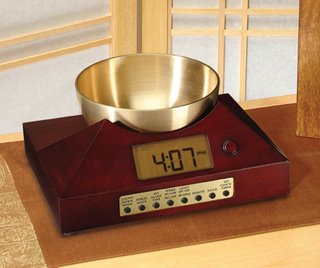 Zen Timepiece with brass bowl
Discover the healing power of sound with singing bowls, tuning forks, and other musical instruments.
Music can move us to tears, help us feel calm or comforted, or inspire us to action. The rhythmic sounds of nature (think of waves breaking on a beach) can bring us into balance. Now researchers are learning more about how music and sound directly affect the healing process.
EVIDENCE. A 2008 study at the University of Maryland School of Medicine revealed that listening to music you consider joyful for 30 minutes helps release endorphins to relieve pain and reduce stress, which can otherwise overload your immune system and lead to a host of health conditions. Another study completed last year at Seattle University in Washington showed that listening to Mozart for 12 minutes three times a week can lower systolic blood pressure by seven points.
YOUR BODY TUNES IN. Researchers say that when you listen to music and sounds, your heartbeat, breath, and brain waves begin to slow down or speed up in response to what you’re hearing. Your body syncs up with the sound, and the result can be an enhanced relaxation response—stress lifts, your heartbeat slows, muscles relax, and your body releases feel-good endorphins—or improved energy levels, depending on the rhythm.
GET STARTED. Try these ways to benefit from sound therapy:
EASE STRESS:
Use tuning forks and singing bowls
“Sonic tools” like tuning forks and singing bowls can soothe an overexcited nervous system, says Jonathan Goldman, author of The Seven Secrets of Sound Healing (Hay House, 2008). Singing bowls create a calming noise when you run a mallet around the rim, and tuning forks hum when tapped.
Try it: Use these tools as frequently as needed, says Goldman. For tuning forks, go to Healing Sounds or Biosonics. For crystal singing bowls, visit Crystal Tones. For Tibetan singing bowls, try Now & Zen, Inc., Headquarter Store, 1638 Pearl Street, Boulder, CO 80302.
RELIEVE INSOMNIA:
Listen to a healing CD
“Music is to the nervous system what nutrients are to the body,” says Joshua Leeds, author of The Power of Sound (Healing Arts Press, 2001). He designs audio CDs with music, special effects, and sounds from the natural world to enhance various activities, such as falling asleep.
Try it: See Sound Remedies or Steven Halpern Inner Peace Music.
SHARPEN YOUR MIND:
Learn an instrument
Studies show that daily practice of a musical instrument can keep the brain young and pliable. It can also help relieve tension as your body actually resonates with the soft energies of the instrument.
Try it: Find a local teacher and ask about beginner lessons. Practicing for five minutes can clear tension and a foggy mind. Use your Zen Timepiece in the morning to wake up to a singing bowl for a gentle and progressive awakening.
Our Zen Timepiece’s acoustic 6-inch brass bowl-gong clock is the world’s ultimate alarm clock, practice timer, and “mindfulness bell.”
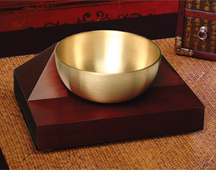 Natural Sound Alarm Clocks & Sound Therapy It fills your environment with beautifully complex tones whenever it strikes. In the morning, its exquisite sounds summon your consciousness into awakening with a series of subtle gongs that provide an elegant beginning to your day. Once you experience the Zen Timepiece’s progressive awakening, you’ll never want to wake up any other way. It also serves as the perfect meditation timer.
adapted from Natural Health Magazine July 2010, by Elizabeth Casey
 Singing Bowl Clocks by Now & Zen called The Zen Timepiece
Posted in Bamboo Chime Clocks, Chime Alarm Clocks, Goodness, Meditation Timers, Meditation Tools, mindfulness practice, Natural Awakening, Progressive Awakening, Well-being, Zen Timepiece by Now & Zen, Zen Timers
 meditation trains your brain Using a magnetic resonance imaging (MRI) machine, Eileen Luders, a re-searcher in the Department of Neurology at the University of California Los Angeles School of Medicine, looks for evidence that meditation changes the physical structure of the brain. Until recently, this idea would have seemed absurd. “Scientists used to believe that the brain reaches its peak in adulthood and doesn’t change—until it starts to decrease in late adulthood,” Luders says. “Today we know that everything we do, and every experience we have, actually changes the brain.” Indeed, Luders finds several differences between the brains of meditators and nonmeditators. In a study published in the journal NeuroImage in 2009, Luders and her colleagues compared the brains of 22 meditators and 22 age-matched nonmeditators and found that the meditators (who practiced a wide range of traditions and had between 5 and 46 years of meditation experience) had more gray matter in re-gions of the brain that are important for attention, emotion regulation, and mental flexibility. Increased gray matter typically makes an area of the brain more efficient or powerful at processing information. Luders believes that the increased gray matter in the meditators’ brains should make them better at controlling their attention, managing their emotions, and making mindful choices.
Why are there differences between the brains of meditators and nonmeditators? It’s a simple matter of training. Neuroscientists now know that the brain you have today is, in part, a reflection of the demands you have placed on it. People learning to juggle, for example, develop more connections in areas of the brain that anticipate moving objects. Medical students undergoing periods of intense learning show similar changes in the hippocampus, an area of the brain important for memory. And mathematicians have more gray matter in regions important for arithmetic and spatial reasoning.
More and more neuroscientists, like Luders, have started to think that learning to meditate is no different from learning mental skills such as music or math. Like anything else that requires practice, meditation is a training program for the brain. “Regular use may strengthen the connections between neurons and can also make new connections,” Luders explains. “These tiny changes, in thousands of connections, can lead to visible changes in the structure of the brain.” Those structural changes, in turn, create a brain that is better at doing whatever you’ve asked it to do. Musicians’ brains could get better at analyzing and creating music. Mathematicians’ brains may get better at solving problems. What do meditators’ brains get better at doing? This is where it gets interesting: It depends on what kind of meditation they do.
Over the past decade, researchers have found that if you practice focusing attention on your breath or a mantra, the brain will restructure itself to make concentration easier. If you practice calm acceptance during meditation, you will develop a brain that is more resilient to stress. And if you meditate while cultivating feelings of love and compassion, your brain will develop in such a way that you spontaneously feel more connected to others.
The Zen Meditation Timer and Clock’s long-resonating Tibetan bell-like chime makes waking and meditating a beautiful experience – its progressive chimes begin your day with grace.
adapted from Yoga Journal, By Kelly McGonigal
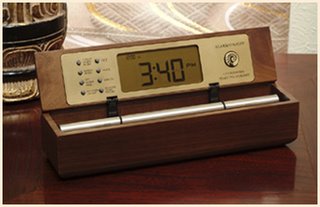 Digital Zen Alarm Clock, a meditation timer and progressive alarm clock Now & Zen’s Meditation Timer Shop
1638 Pearl Street
Boulder, CO 80302
(800) 779-6383
Posted in Bamboo Chime Clocks, intention, Meditation Timers, Meditation Tools, mindfulness practice, Now & Zen Alarm Clocks, Zen Timers
 The Practice of Mediation- Communing with Divinity The Practice of Meditation: Using the Chime Clock to End Your Meditation
In the practice of meditation, there are many forms and theories of meditation, two basic approaches emerge. These two basic types of meditation can be characterized as “meditation with form” and “meditation without form.” In meditation with form, the practitioner focuses on contacting his or her Higher Self, or communing with Divinity. Meditation with form can also involve creative imagery and visualization. Meditation without form concerns going beyond thought into emptiness––transcending the ego-self.
But no matter which type of meditation you choose to practice, meditation is more than simply entering into a dream-like or alpha state. In the practice of meditation you will inevitably progress through a series of developmental stages as you become more adept at journeying deeper within yourself.
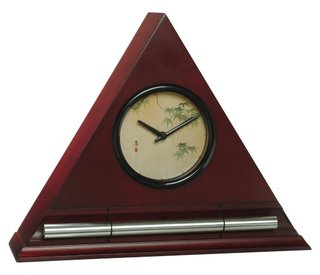 The Practice of Mediation- Japanese Leaves Dial Face in Burgundy Finish by Now & Zen The first and most basic use of the Zen Alarm Clock (a chime clock) in your meditation practice is as a signal of the end of your allotted meditation time. If you want to meditate for 20 minutes, simply set the alarm 20 minutes into the future and begin your meditation. When the first chime strikes you can choose to end there or continue your meditation for about three and a half minutes until the next chime, or even longer. Many meditators find that a “three and a half minute warning” is a perfect interval in which to gradually conclude their longer meditations. The first chime signals the final phase of the meditation and the second chime its conclusion.
 The Practice of Mediation- Stillness The beauty of the chime is that it compliments rather than disturbs the meditative state while acting as an effective timer. No matter how you use it, the sonic clarity of the chime provides an appropriate conclusion to your stillness.
Please visit us in Boulder, CO:
Now & Zen Headquarter Store
1638 Pearl Street
Boulder, CO 80302
(800) 779-6383 or (303) 530-9028
Posted in Chime Alarm Clocks, Meditation Timers, Meditation Tools, Now & Zen Alarm Clocks, Truth, Zen Timers
 Chartres Cathedral, France
Eastern and Western Meditation Traditions: Both Cultures Use Bells and Chimes
Bells and chimes are used in both Eastern and Western meditation traditions. In the Christian monastic tradition, the ringing of the bell during meditation reminds the practitioners to return to the object of worship.
 Zen Monks
Similarly, Zen monks have used gongs and “mindfulness chimes” to begin their meditations and during meditation to bring them out of their mental processes back to the stillpoint of tranquility.
The use of metal alloy bowls for devotional purposes can be traced back to the beginnings of metallurgy in China prior to 1,000 B.C. The bowl that comes with our Zen Timepiece is modeled after a Japanese “rin gong,” or Keisu, that is periodically struck with a stick to punctuate sutra-reading in Buddhist temples.
The Himalayan peoples have been using metal bowls in their rituals and as offerings to Deities since at least 560 B.C. These hand-hammered Himalayan alloy bowls have come to be known as “Tibetan Singing Bowls” because of the unique way they are sounded by rubbing a mallet over the rim so as to produce harmonic resonances and overtones. Although the bowl that comes with our Zen Timepiece is not technically a Tibetan Singing Bowl, it will produce harmonic effects if a mallet or striking stick is rubbed around its edge in a circular motion.
 Bowl-gong Clock has a long-resonating chime sound The bowl that comes with the Zen Timepiece is made from the following five metals: copper, zinc, lead, iron, and tin. It has been formed using the same forging techniques that have been used in Asia for two thousand years. Unlike hand-hammered Himalayan-style bowls, our Zen Timepiece’s rin gong bowl is made using methods which first appeared in Japan in the first century. Following these traditions, our bowl’s long-resonating tone has been carefully selected to bring beauty and harmony to your environment.
Now & Zen – The Gradual Alarm Clock Store
1638 Pearl Street
Boulder, CO 80302
(800) 779-6383
Posted in Chime Alarm Clocks, Japanese Inspired Zen Clocks, Meditation Timers, Meditation Tools, Now & Zen Alarm Clocks, Truth, zen monks, Zen Timepiece by Now & Zen, Zen Timers
 Creating Beautiful Spaces as a Practice
Practitioners of disciplines such as yoga, or reiki often find that a periodic chiming timer is the perfect signal to change positions (or phases of the practice) at a pre-set interval.
 Yoga Practice
The Digital Zen Alarm Clock countdown repeat function in such practices adds not only to the precision and efficiency of the session, but also to its aesthetic value. Because the Digital Zen Alarm Clock’s soothing chime has been tuned with the same Pythagorean method as the specialized tuning forks used by musical therapists, its long-resonating sound helps create a calm environment in which practitioners can get the most out of their discipline.
Also, because the Digital Zen Alarm Clock’s appearance is aesthetically pleasing, it can be placed on an altar or other prominent location where it can add to the visual beauty of the practice environment.
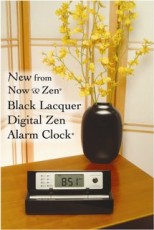 Digital Zen Alarm Clocks by Now & Zen 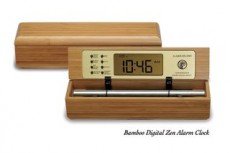 Bamboo Digital Zen Alarm Clock
Posted in Yoga Timers by Now & Zen, Zen Timers

Spiced Hot Dark Chocolate
According to Ayurvedic medicine, warming spices such as cinnamon and cardamom can help boost energy. And by swapping soy milk for regular, you ensure that dark chocolate’s antioxidants will be more fully absorbed.
Ingredients
- 1 quart soy milk
- 6 ounces dark chocolate, coarsely chopped
- 1/2 teaspoon ground cinnamon
- 1/8 to 1/4 teaspoon ground cardamom
- 1/8 teaspoon ground cayenne pepper
- 1/8 teaspoon coarse salt
Directions
- In a small saucepan, combine all ingredients and whisk over medium-low heat until the chocolate has melted completely and the mixture is steaming hot, about 5 minutes. Serve.adapted from www.wholeliving.com
Now & Zen, Inc.
1638 Pearl St.
Boulder, CO 80302
(800) 779-6383
 timer for tea with gentle bowl gong sound
Posted in Uncategorized, Zen Timepiece by Now & Zen, Zen Timers
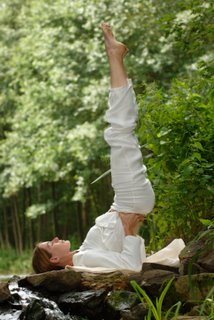 wellness practice of the day Before the hustle-bustle of the holidays throws your routine off-kilter, take some time to reconnect with the earth, viewed in most mind-body traditions as the source of power and stability. “We’re often mentally hovering a few feet above the ground,” says Kate Hanley, author of “The Anywhere, Anytime Chill Guide.” “It’s important to get back in touch with the ground beneath you.” So make a five-minute savasana your new daily habit: Set your Zen Wellness Timer for 5 minutes, lie on your back with your eyes closed, listening to your breath and feeling the earth support you.
adapted from Wholeliving.com, October 2010
Use our unique “Zen Clock” which functions as a Yoga & Meditation Timer. It features a long-resonating acoustic chime that brings your meditation or yoga session to a gradual close, preserving the environment of stillness while also acting as an effective time signal. Our Yoga Timer & Clock can be programmed to chime at the end of the meditation or yoga session or periodically throughout the session as a kind of sonic yantra. The beauty and functionality of the Zen Clock/Timer makes it a meditation tool that can actually help you “make time” for meditation in your life. Bring yourself back to balance.
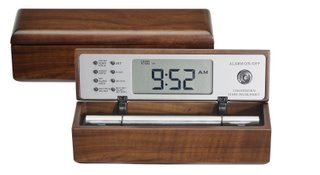 Wellness Timer, The Digital Zen Alarm Clock in Solid Walnut
Now & Zen – The Zen Alarm Clock Store
1638 Pearl Street
Boulder, CO 80302
(800) 779-6383
Posted in intention, mindfulness practice, Well-being, Yoga Timer, Yoga Timers by Now & Zen, Zen Timepiece by Now & Zen, Zen Timers
 meaning and joy Exhaustion Cause: Lack of Meaning and Joy
Exhaustion Cure: Keep a Journal
Start by recording your sources of disconnection and stress. At the end of each day, write down all the things that created stress in your life, how you reacted to them, and the result of your actions. “After a while, you’ll start to notice patterns,” says Merrell. Then record all the things that bring you joy and pleasure.
Now plot your own route to a more meaningful life. Do less of the things that bring you unhappiness and anxiety, and more of those that make you feel good. You might find, for instance, that a nightly chat with your spouse keeps you grounded, whereas watching TV drains you. You could discover that making time for that dance class is worthwhile even when you’re tired, because you always leave energized. Or that you feel renewed after attending religious services or sitting down to meditate using your Zen Meditation Timer. Follow the trail of the positive, and you’re guaranteed to feel a charge. And if you don’t already, consider practicing random acts of kindness. “Giving to others without expecting anything in return is the highest form of connectivity,” says Merrell.
adapted from Body + Soul, September 2009
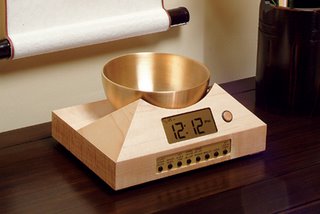 Singing Bowl Meditation Timer and Clock Use our unique “Zen Clock” which functions as a Yoga Timer. It features a long-resonating acoustic chime that brings your meditation or yoga session to a gradual close, preserving the environment of stillness while also acting as an effective time signal. Our Yoga Timer & Clock can be programmed to chime at the end of the meditation or yoga session or periodically throughout the session as a kind of sonic yantra. The beauty and functionality of the Zen Clock/Timer makes it a meditation tool that can actually help you “make time” for meditation in your life. Bring yourself back to balance.
Now & Zen – The Singing Bowl Meditation Timer Store
1638 Pearl Street
Boulder, CO 80302
(800) 779-6383
Posted in Bamboo Chime Clocks, Japanese Inspired Zen Clocks, Meditation Timers, Meditation Tools, Now & Zen Alarm Clocks, Well-being, Zen Timepiece by Now & Zen, Zen Timers
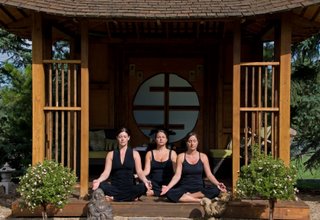 Tea House Meditation
In addition to personal and contemplative uses, the Zen Timers can also be used as a progressively persistent, yet gentle way to bring people together for meetings or sessions, and to disperse them when their meeting time is over.
Having a timer set to signal the end of a meeting can be very useful, especially in intense situations where it is socially difficult to play the role of “meeting police” by cutting people off at the allotted end time. Yet the buzzing of an ordinary alarm clock or beeper watch is also an inappropriately abrupt end. If you shut off the alarm, the meeting often continues unabated; but if you let the alarm keep ringing, the meeting does not have a chance to conclude gracefully. However, when you use your Zen Timepiece as a meeting timer, the first bowl strike of the clock’s automatic, progressive strike sequence provides a gentle warning of the meeting’s agreed-to conclusion, with the following strikes acting to bring the meeting to a timely end. Because the more frequent, ‘alarming’ bowl strikes only occur at the end of the clock’s ten minute strike sequence, these more frequent, disruptive strikes will only be heard if the meeting runs late.
 Use Zen Timers to Begin Meetings On Time
The Zen Timepiece’s progressive bowl strikes are also useful to call meetings to order. A gradually-increasing ten minute “call to order” is a perfect way to begin meetings on time. For use in calling a group to order, the timer is most effective when attendees have advance notice of the purpose of the striking bowl. Whether you are calling your family to the dinner table or beginning a church service, the Zen Timepiece provides a lovely way to begin and to end.
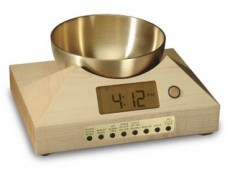 Zen Timepiece by Now & Zen When the clock’s time reaches the alarm time and activates the alarm, its signature “progressive awakening” strike sequence begins with a single bowl strike. Then automatically, three and a half minutes later, the clock strikes again … then in two minutes … then in one minute … so that the chime gradually continues over ten minutes.
Now & Zen Headquarter Store, 1638 Pearl St., Boulder, CO 80302 (800) 779-6383
Posted in Now & Zen Alarm Clocks, Zen Timepiece by Now & Zen, Zen Timers
 three meditation tips Establish your basic practice.
Make sure you have the essentials of your meditation practice clear in your mind. In general, this means establishing a basic sitting posture, training yourself to breathe comfortably, and witnessing your mind from an inner distance—either focusing on your breath or a mantra.
Add time in small increments.
Begin by sitting for 10 to 12 minutes on a regular basis. When you are ready, increase your sitting time to 15 minutes. Then, work your way up to 20 minutes. At that point, your meditation will be well established.
Don’t take on too much.
Ultimately, the length of your meditation will be determined by your mind’s capacity to concentrate. The key to sitting longer is to relax and deepen the process of concentration. From a practical point of view, when the mind becomes so tired of concentrating that you are no longer engaged in the process, the meditation is moving toward its end.
adapted from Yoga International by Rolf Sovik, May/June 2007
Use our unique “Zen Clock” which functions as a Yoga Timer. It features a long-resonating acoustic chime that brings your meditation or yoga session to a gradual close, preserving the environment of stillness while also acting as an effective time signal. Our Yoga Timer & Clock can be programmed to chime at the end of the meditation or yoga session or periodically throughout the session as a kind of sonic yantra. The beauty and functionality of the Zen Clock/Timer makes it a meditation tool that can actually help you “make time” for meditation in your life. Bring yourself back to balance
 Meditation Timers and Clocks with Chime in Bamboo, Walnut, Maple, and Black Lacquer Now & Zen – The Zen Timer Store
1638 Pearl Street
Boulder, CO 80302
(800) 779-6383
Posted in Meditation Timers, Meditation Tools, mindfulness practice, Well-being, Zen Timers
« Previous Page — « Previous Entries
Next Entries » — Next Page »
|
|
|
|